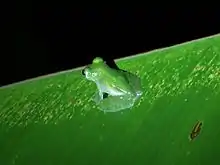Hyalinobatrachium valerioi
Hyalinobatrachium valerioi, sometimes known as the La Palma glass frog, is a species of frog in the family Centrolenidae. It is found in central Costa Rica and south to Panama and the Pacific lowlands and slopes of western Colombia and Ecuador; also in the Magdalena River Valley of Colombia (Colombian distribution is poorly resolved).[1][2][3][4]
| Hyalinobatrachium valerioi | |
|---|---|
 | |
| Scientific classification | |
| Kingdom: | Animalia |
| Phylum: | Chordata |
| Class: | Amphibia |
| Order: | Anura |
| Family: | Centrolenidae |
| Genus: | Hyalinobatrachium |
| Species: | H. valerioi |
| Binomial name | |
| Hyalinobatrachium valerioi (Dunn, 1931) | |
| Synonyms | |
|
Centrolene valerioi Dunn, 1931 | |
Description
Males grow to 24 mm (0.94 in) and females to 26 mm (1.0 in) in snout–vent length. The dorsum is spotted yellow, with green reticulations between the spots. There might be some small dark spots in the green areas. The ventral surface is transparent, however the heart is covered by white tissue and is not visible. Also the liver and digestive tract are white. Their eye color is gold.[4]
Hyalinobatrachium valerioi glass frogs are carnivores, their diet mainly including small insects like crickets, moths, flies, spiders, and other smaller frogs.[5]
The egg clutches, containing no more than 40 eggs, are laid on the underside of leaves over streams. Contrary to most other glass frogs, the male remains with its egg clutches also during daylight hours, performing 24-hour egg attendance.[1][4][6]
Habitat and conservation
Its natural habitats are moist primary and secondary lowland forests. Adult frogs are typically found in bushes and trees along forest streams. The species tolerates some habitat modification, provided that vegetation over streams remains.[1]
Hyalinobatrachium valerioi is declining in parts of its range while it is considered stable in others. Habitat loss (deforestation) is a significant threat, as is pollution from the spraying of illegal crops.[1]
References
- Solís, F.; Ibáñez, R.; Chaves, G.; Savage, J.; Bolaños, F.; Kubicki, B.; Jaramillo, C.; Fuenmayor, Q.; Coloma, L.A.; Ron, S.R.; Cisneros-Heredia, D.; Bolívar, W.; Almendáriz, A. (2008). "Hyalinobatrachium valerioi". IUCN Red List of Threatened Species. 2008: e.T55036A11243874. doi:10.2305/IUCN.UK.2008.RLTS.T55036A11243874.en.
- Frost, Darrel R. (2016). "Hyalinobatrachium valerioi (Dunn, 1931)". Amphibian Species of the World: an Online Reference. Version 6.0. American Museum of Natural History. Retrieved 20 March 2016.
- Acosta Galvis, A. R. & D. Cuentas (2016). "Hyalinobatrachium valerioi (Dunn, 1931)". Lista de los Anfibios de Colombia V.05.2015. www.batrachia.com. Retrieved 20 March 2016.
- "Hyalinobatrachium valerioi Dunn, 1931". Amphibians of Panama. Smithsonian Tropical Research Institute. Retrieved 20 March 2016.
- "Reticulated Glass Frog Hyalinobatrachium valerioi". henryvilaszoo.gov. Henry Vilas Zoo, Madison, WI. Archived from the original on 11 April 2020. Retrieved 30 August 2020.
- Vockenhuber, E.A.; W. Hödl; U. Karpfen (2008). "Reproductive behaviour of the glass frog Hyalinobatrachium valerioi Anura: Centrolenidae) at the tropical stream Quebrada Negra (La Gamba, Costa Rica)" (PDF). Stapfia. 88 (zugleich Kataloge der oberösterreichischen Landesmuseen Neue Serie 80): 335–348.
